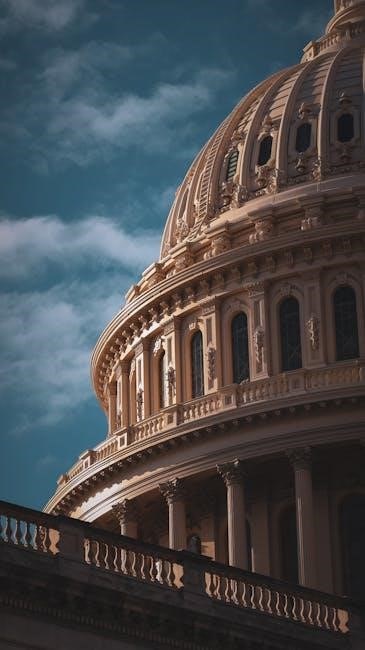The Logic of American Politics 11th Edition: Overview
The Logic of American Politics 11th Edition provides a comprehensive analysis of the U.S. political system, emphasizing institutional design and collective action problems in governance.
Welcome to the 11th Edition of The Logic of American Politics, a leading textbook that equips students with essential tools to understand the complexities of the U.S. political system. This edition builds on the legacy of previous versions while incorporating fresh insights and updated analysis to reflect the evolving political landscape. With a focus on institutional design and collective action problems, the book provides a framework for analyzing how political actors navigate challenges and opportunities in governance. The 11th Edition includes new coverage of recent events, such as the 2022 midterm elections and the ongoing impact of the COVID-19 pandemic, offering students a timely and relevant perspective on American politics. Authored by renowned scholars Samuel Kernell, Gary C. Jacobson, Thad Kousser, Lynn Vavreck, and Timothy R. Johnson, this edition ensures students gain a deeper understanding of how political institutions function and interact in the modern era.

Key Features of the Textbook
The 11th Edition of The Logic of American Politics offers several key features that enhance student learning and engagement. It provides a comprehensive analysis of the U.S. political system, with a strong emphasis on institutional design and collective action problems. The textbook includes updated coverage of recent events, such as the 2022 midterm elections and the COVID-19 pandemic, ensuring relevance and timeliness. Additionally, it incorporates digital tools like highlights, bookmarks, and note-taking options for an enhanced learning experience. The authors also focus on the intersection of political institutions and public policy, offering clear explanations of complex concepts. With its accessible writing style and structured approach, this edition serves as an invaluable resource for students seeking to understand the logic behind American governance.
Target Audience and Purpose
The 11th Edition of The Logic of American Politics is primarily designed for undergraduate students enrolled in American government and politics courses. It serves as a foundational textbook, aiming to equip students with a deeper understanding of the U.S. political system. The book is also valuable for political science majors, researchers, and anyone seeking to grasp the complexities of American governance. Its purpose is to provide a clear, analytical framework for understanding political institutions, processes, and behaviors. By focusing on institutional design and collective action problems, the textbook helps readers develop critical thinking skills to analyze contemporary political challenges. It is particularly useful for those interested in the historical and theoretical underpinnings of American politics, as well as its practical applications in shaping public policy.
The Nationalization of Politics
The text explores the centralization of political authority in the U.S., examining the Constitution, federalism, and civil rights as foundational elements shaping national governance and unity.
The Constitution and Its Historical Context
The Constitution is the cornerstone of American governance, establishing the framework for the federal government and the relationship between the national and state levels. It reflects the historical context of the Founding Era, balancing federal authority with state rights. The document’s drafting and ratification were shaped by debates over representation, power distribution, and individual liberties. Its preamble emphasizes the goals of unity, justice, and liberty, while amendments, particularly the Bill of Rights, ensure protections for citizens. The Constitution’s enduring relevance lies in its adaptability, as seen through landmark Supreme Court decisions and amendments addressing civil rights and liberties. This foundational document continues to guide American politics, providing the structural logic for governance and collective action. Its historical evolution underscores the dynamic nature of U.S; democracy and its ability to address contemporary challenges.

Federalism: Division of Power
Federalism in the United States divides power between the national government and the states, creating a system of shared authority. This division, rooted in the Constitution, balances national unity with state autonomy. The federal government holds powers such as foreign policy and national defense, while states manage local matters like education and law enforcement. The Constitution’s Supremacy Clause ensures federal laws take precedence, yet states retain significant influence through their legislative and judicial systems. Federalism fosters innovation at the state level while allowing for uniform national policies. Over time, the balance has shifted, with the federal government gaining more authority, particularly in areas like civil rights and economic regulation. This dynamic system adaptsto contemporary challenges, maintaining a framework where both levels of government collaborate and compete to address public needs.
Civil Rights and Liberties
Civil rights and liberties are foundational to American democracy, ensuring equal protection under the law and safeguarding individual freedoms. The Constitution, particularly the Bill of Rights, establishes protections for free speech, religious freedom, and due process. Over time, landmark Supreme Court decisions have expanded these rights, such as Brown v. Board of Education (1954), which struck down segregation, and Obergefell v. Hodges (2015), legalizing same-sex marriage nationwide. The Civil Rights Act of 1964 and the Voting Rights Act of 1965 further codified these protections, addressing racial discrimination and ensuring voting rights. The judiciary plays a crucial role in interpreting and enforcing these rights, balancing individual freedoms with societal needs. Contemporary debates often center on issues like LGBTQ+ rights, racial justice, and the tension between liberty and national security, highlighting the ongoing evolution of civil rights in America.

The Institutions of Government
The U.S. government’s institutions—Congress, the presidency, bureaucracy, and judiciary—work together to create, implement, and interpret policies, balancing power while addressing societal needs and political challenges effectively.
Congress: Structure and Function
Congress, as the bicameral legislature, consists of the Senate and the House of Representatives. The Senate has 100 members, with two representing each state, while the House has 435 members, allocated by population. Congress’s primary role is to make laws, with powers including taxing, spending, and regulating commerce. The legislative process involves proposing, debating, and voting on bills, which must pass both chambers and be signed by the president to become law. Congress also conducts oversight of the executive branch, holds hearings, and approves presidential appointments. The Logic of American Politics 11th Edition highlights Congress’s ability to balance representation and governance, addressing collective action problems through its structured deliberative process. Despite challenges like polarization, Congress remains central to U.S. governance, ensuring accountability and shaping national policy.
The Presidency: Powers and Limitations
The presidency is a central institution in American governance, wielding significant authority while operating within constitutional and political constraints. The president serves as both the head of state and government, commanding the military and conducting foreign policy. Executive powers include vetoing legislation, appointing federal judges and cabinet members, and enforcing laws. However, these powers are checked by Congress and the judiciary. The Logic of American Politics 11th Edition explores how the presidency has evolved, particularly in crises, where wartime and economic emergencies have expanded executive authority. Yet, limitations like congressional oversight, impeachment proceedings, and judicial review ensure accountability. The text highlights the delicate balance between presidential leadership and constitutional restraints, illustrating how the office navigates collective action challenges while maintaining democratic accountability. This duality ensures the presidency remains a powerful yet constrained institution in American democracy.
The Bureaucracy: Role in Policy Implementation

The bureaucracy is integral to American governance, responsible for executing policies established by Congress and the executive branch. It encompasses numerous agencies that transform legislative and executive directives into operational programs. The Logic of American Politics 11th Edition highlights the bureaucracy’s expertise in managing intricate tasks such as regulatory oversight and public service administration. Despite its essential role, the bureaucracy is often criticized for inefficiencies and susceptibility to political influence, which can hinder its effectiveness. Additionally, the hierarchical structure of bureaucratic agencies can sometimes lead to bureaucratic red tape, slowing down decision-making processes. These challenges notwithstanding, the bureaucracy remains vital for the implementation of national policies and ensuring administrative stability across governmental functions.
The Federal Judiciary: Supreme Court and Its Impact
The federal judiciary, particularly the Supreme Court, plays a pivotal role in interpreting laws and ensuring constitutional adherence. The Logic of American Politics 11th Edition emphasizes the Court’s authority to shape legal and political landscapes through landmark decisions. Its rulings on civil rights, liberties, and federal power have profound implications for American society. The Supreme Court’s decisions often address conflicts between branches of government and levels of federalism, ensuring a balance of power. The judiciary’s independence is crucial, though its legitimacy can be contested, especially in politically charged cases. The Court’s impact extends beyond legal doctrine, influencing public opinion and policy outcomes. Its decisions are final, making it a cornerstone of American governance and a key player in resolving constitutional disputes. The 11th Edition provides in-depth analysis of these dynamics, offering insights into the judiciary’s enduring influence.

The Public’s Influence on National Policy
The Logic of American Politics 11th Edition explores how public opinion, voting, campaigns, and interest groups shape national policy, emphasizing the media’s role in influencing political outcomes.
Public Opinion: Formation and Measurement
Public opinion in the Logic of American Politics 11th Edition is explored as a critical driver of political decision-making. The textbook examines how public opinion forms through socialization, media, and personal experiences, shaping policy preferences. It delves into the challenges of measuring opinion accurately, discussing methodologies like surveys, polling, and focus groups. The authors highlight the dynamic nature of public opinion, influenced by external events and political elites. Understanding these processes is essential for grasping how public sentiment translates into political action and policy outcomes. The chapter emphasizes the interplay between public opinion and institutional responses, illustrating its significance in democratic governance. This section provides students with tools to analyze and interpret the role of public opinion in shaping American politics effectively.
Voting, Campaigns, and Elections
The Logic of American Politics 11th Edition examines the complexities of voting, campaigns, and elections as central to democratic governance; The textbook explores how campaigns strategically mobilize voters, leveraging resources, media, and messaging to influence outcomes. It analyzes voter behavior, including factors like party loyalty, issue alignment, and candidate traits. The role of money in politics and the impact of campaign finance laws are also discussed. The chapter covers the Electoral College system, voter turnout trends, and the growing influence of digital media in shaping campaigns. Additionally, it addresses election integrity, voter access, and the consequences of electoral outcomes for policy and representation. This section provides insights into the dynamics of political competition and the ways in which elections reflect and shape American democracy.
Political Parties and Interest Groups
The Logic of American Politics 11th Edition delves into the pivotal roles of political parties and interest groups in shaping U.S. governance. Political parties are examined as coalitions that organize and contest elections, while interest groups advocate for specific policies. The textbook explores how these entities influence legislative processes, campaign finance, and public opinion. It highlights the growing polarization of political parties and the rise of special interest lobbying. The chapter also discusses the strategies used by these groups to mobilize support and sway policy outcomes. By analyzing their interactions, the text reveals how political parties and interest groups reflect and shape the priorities of American democracy, emphasizing their impact on representation and decision-making. This section provides a detailed understanding of their roles in the political landscape.
The News Media: Role in Shaping Politics
The Logic of American Politics 11th Edition examines the profound influence of the news media on political processes and public perception. The textbook highlights how the media shapes political discourse, frames issues, and impacts voter behavior. It discusses the evolution of media landscapes, including the rise of 24-hour news cycles and social media platforms. The chapter explores how media polarization contributes to political polarization, influencing public opinion and electoral outcomes. Additionally, it addresses the role of fact-checking, misinformation, and the media’s responsibility in holding political actors accountable. By analyzing these dynamics, the text underscores the media’s dual role as both a reflector and shaper of American politics, emphasizing its significance in democracy and governance. This section provides insights into the complex interplay between media, politics, and public engagement.

